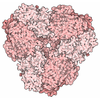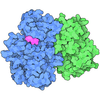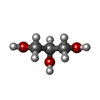+ Open data
Open data
- Basic information
Basic information
| Entry | Database: PDB / ID: 8s1m | ||||||
|---|---|---|---|---|---|---|---|
| Title | Crystal structure of human GABARAP fused to EGFR (1076-1099) | ||||||
 Components Components | Epidermal growth factor receptor,Gamma-aminobutyric acid receptor-associated protein | ||||||
 Keywords Keywords | PROTEIN BINDING / Atg8 / Receptor-trafficking | ||||||
| Function / homology |  Function and homology information Function and homology informationpositive regulation of protein K48-linked ubiquitination / regulation of Rac protein signal transduction / GABA receptor binding / phosphatidylethanolamine binding / TBC/RABGAPs / cellular response to nitrogen starvation / multivesicular body, internal vesicle lumen / negative regulation of cardiocyte differentiation / Shc-EGFR complex / positive regulation of protein kinase C signaling ...positive regulation of protein K48-linked ubiquitination / regulation of Rac protein signal transduction / GABA receptor binding / phosphatidylethanolamine binding / TBC/RABGAPs / cellular response to nitrogen starvation / multivesicular body, internal vesicle lumen / negative regulation of cardiocyte differentiation / Shc-EGFR complex / positive regulation of protein kinase C signaling / Inhibition of Signaling by Overexpressed EGFR / microtubule associated complex / epidermal growth factor receptor activity / EGFR interacts with phospholipase C-gamma / regulation of peptidyl-tyrosine phosphorylation / epidermal growth factor binding / response to UV-A / PLCG1 events in ERBB2 signaling / ERBB2-EGFR signaling pathway / morphogenesis of an epithelial fold / PTK6 promotes HIF1A stabilization / ERBB2 Activates PTK6 Signaling / Macroautophagy / digestive tract morphogenesis / Signaling by EGFR / intracellular vesicle / regulation of neurotransmitter receptor localization to postsynaptic specialization membrane / negative regulation of epidermal growth factor receptor signaling pathway / eyelid development in camera-type eye / cerebral cortex cell migration / protein insertion into membrane / smooth endoplasmic reticulum / ERBB2 Regulates Cell Motility / protein tyrosine kinase activator activity / Respiratory syncytial virus (RSV) attachment and entry / autophagosome membrane / Signaling by ERBB4 / PI3K events in ERBB2 signaling / axoneme / positive regulation of phosphorylation / extrinsic apoptotic signaling pathway via death domain receptors / autophagosome assembly / positive regulation of peptidyl-serine phosphorylation / autophagosome maturation / Estrogen-dependent nuclear events downstream of ESR-membrane signaling / hair follicle development / MAP kinase kinase kinase activity / GAB1 signalosome / positive regulation of G1/S transition of mitotic cell cycle / embryonic placenta development / protein targeting / salivary gland morphogenesis / beta-tubulin binding / mitophagy / sperm midpiece / Signaling by ERBB2 / TFAP2 (AP-2) family regulates transcription of growth factors and their receptors / GRB2 events in EGFR signaling / transmembrane receptor protein tyrosine kinase activity / SHC1 events in EGFR signaling / EGFR Transactivation by Gastrin / GRB2 events in ERBB2 signaling / ossification / SHC1 events in ERBB2 signaling / autophagosome / basal plasma membrane / positive regulation of DNA repair / cellular response to epidermal growth factor stimulus / positive regulation of DNA replication / epithelial cell proliferation / positive regulation of epithelial cell proliferation / Signal transduction by L1 / positive regulation of protein localization to plasma membrane / NOTCH3 Activation and Transmission of Signal to the Nucleus / cellular response to amino acid stimulus / phosphatidylinositol 3-kinase/protein kinase B signal transduction / cellular response to estradiol stimulus / EGFR downregulation / clathrin-coated endocytic vesicle membrane / Signaling by ERBB2 TMD/JMD mutants / Constitutive Signaling by EGFRvIII / cell-cell adhesion / receptor protein-tyrosine kinase / Signaling by ERBB2 ECD mutants / GABA-ergic synapse / Signaling by ERBB2 KD Mutants / negative regulation of protein catabolic process / positive regulation of miRNA transcription / kinase binding / microtubule cytoskeleton organization / ruffle membrane / Downregulation of ERBB2 signaling / epidermal growth factor receptor signaling pathway / positive regulation of protein phosphorylation / positive regulation of fibroblast proliferation / cell morphogenesis / neuron differentiation / HCMV Early Events / Constitutive Signaling by Aberrant PI3K in Cancer / actin filament binding Similarity search - Function | ||||||
| Biological species |  Homo sapiens (human) Homo sapiens (human) | ||||||
| Method |  X-RAY DIFFRACTION / X-RAY DIFFRACTION /  SYNCHROTRON / SYNCHROTRON /  MOLECULAR REPLACEMENT / Resolution: 2.05 Å MOLECULAR REPLACEMENT / Resolution: 2.05 Å | ||||||
 Authors Authors | Ueffing, A. / Willbold, D. / Weiergraeber, O.H. | ||||||
| Funding support |  Germany, 1items Germany, 1items
| ||||||
 Citation Citation |  Journal: Febs Lett. / Year: 2024 Journal: Febs Lett. / Year: 2024Title: GABARAP interacts with EGFR - supporting the unique role of this hAtg8 protein during receptor trafficking. Authors: Uffing, A. / Weiergraber, O.H. / Schwarten, M. / Hoffmann, S. / Willbold, D. | ||||||
| History |
|
- Structure visualization
Structure visualization
| Structure viewer | Molecule:  Molmil Molmil Jmol/JSmol Jmol/JSmol |
|---|
- Downloads & links
Downloads & links
- Download
Download
| PDBx/mmCIF format |  8s1m.cif.gz 8s1m.cif.gz | 79.3 KB | Display |  PDBx/mmCIF format PDBx/mmCIF format |
|---|---|---|---|---|
| PDB format |  pdb8s1m.ent.gz pdb8s1m.ent.gz | 49.5 KB | Display |  PDB format PDB format |
| PDBx/mmJSON format |  8s1m.json.gz 8s1m.json.gz | Tree view |  PDBx/mmJSON format PDBx/mmJSON format | |
| Others |  Other downloads Other downloads |
-Validation report
| Summary document |  8s1m_validation.pdf.gz 8s1m_validation.pdf.gz | 354.8 KB | Display |  wwPDB validaton report wwPDB validaton report |
|---|---|---|---|---|
| Full document |  8s1m_full_validation.pdf.gz 8s1m_full_validation.pdf.gz | 396.3 KB | Display | |
| Data in XML |  8s1m_validation.xml.gz 8s1m_validation.xml.gz | 4.3 KB | Display | |
| Data in CIF |  8s1m_validation.cif.gz 8s1m_validation.cif.gz | 6 KB | Display | |
| Arichive directory |  https://data.pdbj.org/pub/pdb/validation_reports/s1/8s1m https://data.pdbj.org/pub/pdb/validation_reports/s1/8s1m ftp://data.pdbj.org/pub/pdb/validation_reports/s1/8s1m ftp://data.pdbj.org/pub/pdb/validation_reports/s1/8s1m | HTTPS FTP |
-Related structure data
| Similar structure data | Similarity search - Function & homology  F&H Search F&H Search |
|---|---|
| Experimental dataset #1 | Data reference:  10.15151/ESRF-DC-1524662410 / Data set type: diffraction image data 10.15151/ESRF-DC-1524662410 / Data set type: diffraction image data |
- Links
Links
- Assembly
Assembly
| Deposited unit | 
| ||||||||||||
|---|---|---|---|---|---|---|---|---|---|---|---|---|---|
| 1 |
| ||||||||||||
| Unit cell |
|
- Components
Components
| #1: Protein | Mass: 16905.242 Da / Num. of mol.: 1 Source method: isolated from a genetically manipulated source Details: EGFR(1052-1075) fused to N-terminus of GABARAP,EGFR(1052-1075) fused to N-terminus of GABARAP,EGFR(1052-1075) fused to N-terminus of GABARAP,EGFR(1052-1075) fused to N-terminus of GABARAP Source: (gene. exp.)  Homo sapiens (human) / Gene: EGFR, ERBB, ERBB1, HER1, GABARAP, FLC3B, HT004 / Production host: Homo sapiens (human) / Gene: EGFR, ERBB, ERBB1, HER1, GABARAP, FLC3B, HT004 / Production host:  References: UniProt: P00533, UniProt: O95166, receptor protein-tyrosine kinase |
|---|---|
| #2: Chemical | ChemComp-CL / |
| #3: Chemical | ChemComp-GOL / |
| #4: Water | ChemComp-HOH / |
| Has ligand of interest | N |
| Has protein modification | N |
-Experimental details
-Experiment
| Experiment | Method:  X-RAY DIFFRACTION / Number of used crystals: 1 X-RAY DIFFRACTION / Number of used crystals: 1 |
|---|
- Sample preparation
Sample preparation
| Crystal | Density Matthews: 2.56 Å3/Da / Density % sol: 51.96 % |
|---|---|
| Crystal grow | Temperature: 293 K / Method: vapor diffusion, sitting drop / pH: 5.6 Details: 0.17 M ammonium acetate 0.085 M sodium citrate 25.5% PEG 4000 15% Glycerol |
-Data collection
| Diffraction | Mean temperature: 100 K / Serial crystal experiment: N |
|---|---|
| Diffraction source | Source:  SYNCHROTRON / Site: SYNCHROTRON / Site:  ESRF ESRF  / Beamline: MASSIF-3 / Wavelength: 0.9677 Å / Beamline: MASSIF-3 / Wavelength: 0.9677 Å |
| Detector | Type: DECTRIS EIGER X 4M / Detector: PIXEL / Date: Sep 17, 2022 |
| Radiation | Protocol: SINGLE WAVELENGTH / Monochromatic (M) / Laue (L): M / Scattering type: x-ray |
| Radiation wavelength | Wavelength: 0.9677 Å / Relative weight: 1 |
| Reflection | Resolution: 2.05→41.35 Å / Num. obs: 11007 / % possible obs: 100 % / Redundancy: 20.1 % / Biso Wilson estimate: 57.43 Å2 / CC1/2: 1 / Net I/σ(I): 21.91 |
| Reflection shell | Resolution: 2.05→2.1 Å / Redundancy: 20.1 % / Mean I/σ(I) obs: 1.01 / Num. unique obs: 798 / CC1/2: 0.365 / % possible all: 99.1 |
- Processing
Processing
| Software |
| |||||||||||||||||||||||||||||||||||||||||||||||||
|---|---|---|---|---|---|---|---|---|---|---|---|---|---|---|---|---|---|---|---|---|---|---|---|---|---|---|---|---|---|---|---|---|---|---|---|---|---|---|---|---|---|---|---|---|---|---|---|---|---|---|
| Refinement | Method to determine structure:  MOLECULAR REPLACEMENT / Resolution: 2.05→41.35 Å / SU ML: 0.3497 / Cross valid method: FREE R-VALUE / σ(F): 1.35 / Phase error: 33.7698 MOLECULAR REPLACEMENT / Resolution: 2.05→41.35 Å / SU ML: 0.3497 / Cross valid method: FREE R-VALUE / σ(F): 1.35 / Phase error: 33.7698 Stereochemistry target values: GeoStd + Monomer Library + CDL v1.2
| |||||||||||||||||||||||||||||||||||||||||||||||||
| Solvent computation | Shrinkage radii: 0.9 Å / VDW probe radii: 1.1 Å / Solvent model: FLAT BULK SOLVENT MODEL | |||||||||||||||||||||||||||||||||||||||||||||||||
| Displacement parameters | Biso mean: 72.05 Å2 | |||||||||||||||||||||||||||||||||||||||||||||||||
| Refinement step | Cycle: LAST / Resolution: 2.05→41.35 Å
| |||||||||||||||||||||||||||||||||||||||||||||||||
| Refine LS restraints |
| |||||||||||||||||||||||||||||||||||||||||||||||||
| LS refinement shell |
| |||||||||||||||||||||||||||||||||||||||||||||||||
| Refinement TLS params. | Method: refined / Origin x: 24.4256493167 Å / Origin y: 31.1975939398 Å / Origin z: 2.16098169233 Å
| |||||||||||||||||||||||||||||||||||||||||||||||||
| Refinement TLS group | Selection details: chain 'A' and (resid 1 through 117 ) |
 Movie
Movie Controller
Controller



 PDBj
PDBj




















